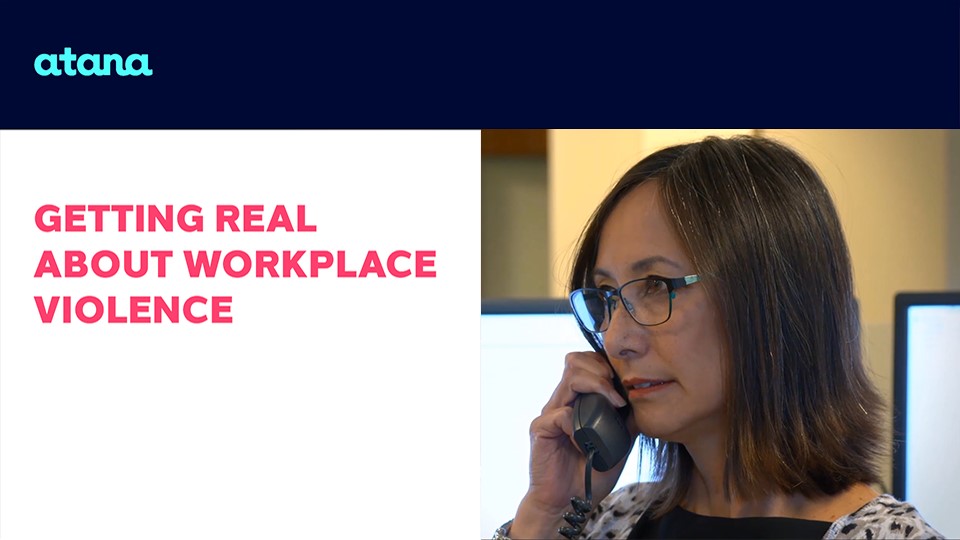
With the New York Retail Worker Safety Act taking effect on June 2, 2025, organizations are reevaluating their approaches to workplace violence prevention. While "zero tolerance" policies have been a staple in many workplaces, it's crucial to assess their effectiveness and potential unintended consequences.
With the New York Retail Worker Safety Act taking effect on June 2, 2025, organizations are reevaluating their approaches to workplace violence prevention. While "zero tolerance" policies have been a staple in many workplaces, it's crucial to assess their effectiveness and potential unintended consequences.
The Problem with Zero Tolerance
- Managerial Paralysis – Supervisors might feel constrained by inflexible policies, unsure how to handle nuanced situations. For example, what if an employee were to make an offhand comment in frustration during a tense meeting…something that lands uncomfortably but isn’t overtly threatening? Does that warrant immediate disciplinary action, or just a conversation to clarify intent and to reestablish positive connection? That kind of ambiguity can lead to hesitation, or worse, this uncertainty can lead to inaction, further compromising workplace safety.
- Legal and Cultural Implications – Rigid policies can also expose organizations to legal risks, especially if they're applied inconsistently. Moreover, they can erode trust, making employees feel unsupported and undervalued.
Zero tolerance sounds decisive and firm—a clear stance against workplace misconduct. But, in practice, such rigid policies can have unintended consequences that undermine their very purpose.
One Size Doesn’t Fit All
When we're talking about workplace violence prevention, we're not only addressing overt acts of intimidation, aggression, or physical harm. The real challenge often lies in how to respond to early signs of concern; things like tense verbal outbursts, passive-aggressive remarks, or behavior that feels off but isn't clearly out of bounds. These moments might be interpreted as minor offenses, or they might be nothing at all…someone just having a bad day. But that's the point. These early behaviors live in a gray area, where context matters, and where interpretation requires judgment. Rigid zero-tolerance policies leave little room for that nuance, and often pressure managers to treat every misstep as a mandate, rather than a moment for relational insight, clarification, or course correction.
These behaviors live in a gray area, where context matters, and where interpretation requires judgment.
So, zero tolerance sounds like a bold stance. But here's the question that too often gets overlooked: What happens when boldness results in blindness?
In the real world, workplace behavior doesn’t fall neatly into binary categories. Not every incident of misconduct looks the same. Not every outburst is premeditated. And not every employee needs to be shown the door to restore safety and security.
So why do some policies attempt to treat every violation the same?
Policy Rigidity Has Pitfalls
- Legal Vulnerabilities – When policies remove discretion, they also remove judgment…and that can create problems in court. If an employee is terminated for a minor offense under a zero-tolerance policy, they may successfully argue that the punishment didn't fit the offense. Worse, if exceptions are made inconsistently (say, for senior employees), organizations may face claims of unequal treatment or discrimination.
An example to consider...
A senior employee lashes out verbally in a stressful moment and is quietly given a warning. Weeks later, a new hire commits a similar offense and is terminated per the company's zero-tolerance policy. Same behavior. Different outcome. Now the company's facing an internal grievance—and possibly an external claim.
- Chilling Effect on Reporting – Employees may hesitate to report situations or behavior that makes them uncomfortable, fearing that even minor infractions could lead to severe penalties like immediate termination. This reluctance can allow issues to fester, escalating into more significant problems.
- Managerial Uncertainty – Frontline managers often find themselves caught between "company policy" and "common sense." A rigid policy might demand harsh consequences even when a coaching conversation would suffice. That pressure can paralyze action, especially when leaders fear triggering disproportionate outcomes.
- Morale and Trust Erosion – When employees see colleagues punished harshly for gray-area incidents—or spared consequences due to rank—it can breed resentment and fear. The policy that was meant to ensure fairness can end up undermining it.
What's the alternative? Flexibility doesn't mean being soft. It means being smart…calibrating your response based on context, intent, and impact.
Policy Language as a Tool for Prevention
Words Matter: How Policy Language Shapes Safety Outcomes
It's easy to think of policy language as just paperwork; dry legalese that checks a compliance box.
But in truth, the words you choose shape behavior, guide decisions, and determine whether people feel safe enough to speak up.
When it comes to preventing workplace violence, language isn't just symbolic. It's operational.
Especially when it comes to preventing workplace violence, language isn't just symbolic. It's operational.
What Zero Tolerance Really Communicates
While well-intended, the phrase "zero tolerance" often conveys unintended subtext. It implies swift and severe punishment. It suggests there's no room for discretion or dialogue. And it creates the illusion that prevention is simple—just ban bad behavior and move on.
But risk doesn't work that way. And neither do people. Behavioral risk is dynamic. It requires attention, adaptation, and response in real time…not one-size-fits-all consequences.
Why Employees Stay Silent
Research consistently shows that extreme language, like zero tolerance, can suppress early reporting. People worry they'll get someone fired over a single mistake. They don't want to be responsible for a disproportionate outcome.
So they say nothing. And that silence is where risk can begin to build.
Language That Builds Trust
The goal isn't to water things down. It's to speak with clarity and care.
- Instead of saying zero tolerance, try: "Violence and threats will not be tolerated. All reports will be taken seriously and addressed appropriately."
- Instead of mandating fixed consequences, maybe say: "Corrective or disciplinary action will be taken based on the severity of the behavior, which may include coaching, suspension, or termination."
This kind of language communicates both strength and fairness. It empowers people to speak up and reassures them that what follows will be thoughtful, not automatic.
Smarter Alternatives That Actually Work
Moving Beyond Slogans: Building Policies That Actually Work
If we've learned anything from years of research, frontline experience, and legal precedent, it's this: tough talk doesn't always lead to safe outcomes.
Zero tolerance might sound resolute, but true prevention calls for clarity, consistency, and a system that people actually trust. So what does that look like?
Tough talk doesn't always lead to safe outcomes.
5 Principles for a Strong, Flexible Policy
- Be Clear Without Being Rigid – "Violence and threats will not be tolerated. All reports will be taken seriously and addressed appropriately."
This frames the organization's stance while leaving room for context-based response. - Show a Range of Possible Consequences – "Disciplinary action will be based on the severity of the behavior and may include training, suspension, or termination."
This tells employees that the process is both fair and thoughtful. - Encourage Reporting and Protect the Reporter – "Employees who report in good faith will be supported, and retaliation will not be tolerated."
This builds trust and empowers early intervention. - Train Managers on How to Apply the Policy – The best-written policy fails without well-prepared people. Supervisors need training on how to assess behavior, apply proportional responses, and document decisions transparently.
- Align Words with Action – Consistency is the heart of credibility. A policy should never be a document that collects dust; it should be reinforced through daily practice and leadership modeling.
From Fear to Functionality
Policies don't prevent violence. People do…when they're trusted, trained, and supported. And people engage best with systems that feel human, not harsh.
That's the shift: From punishment to prevention. From slogans to systems. From fear to functionality.
Rethinking zero tolerance isn't about lowering standards, it's about raising them. Raising the bar on what it means to lead with clarity. To act with empathy. To take safety seriously…not just in language, but in culture and conduct.
Rethinking zero tolerance isn't about lowering standards, it's about raising them.
If your organization has been relying on outmoded, rigid rules to navigate complex risks, now is the time to step forward.
About the Authors


James Sporleder - James has 30 years’ experience in the security industry. With a unique background in specialized captivity survival, James has trained thousands of US military personnel from some of the most elite units in the US Department of Defense. He’s worked in the corporate arena for nearly 20 years, focusing on the development and implementation of specialized training programs and helping more than 50 percent of the Fortune 100 prepare for and respond to emerging challenges related to workplace violence, intimate partner violence, and extreme violence such as active shooter.
James Sporleder - James has 30 years’ experience in the security industry. With a unique background in specialized captivity survival, James has trained thousands of US military personnel from some of the most elite units in the US Department of Defense. He’s worked in the corporate arena for nearly 20 years, focusing on the development and implementation of specialized training programs and helping more than 50 percent of the Fortune 100 prepare for and respond to emerging challenges related to workplace violence, intimate partner violence, and extreme violence such as active shooter.


Don Robinson - Don is an accomplished security and threat management professional who served 23 years with the FBI, where he led investigations into counterterrorism, organized crime, and civil rights violations. After retiring from the FBI, Don transitioned to the behavioral health field, where he led the development of one of the area’s first Behavioral Health Crisis Centers at a major medical center. Don is now in private practice and advises corporate clients on best practices in workplace violence prevention, behavioral threat assessment, and crisis response.
Don Robinson - Don is an accomplished security and threat management professional who served 23 years with the FBI, where he led investigations into counterterrorism, organized crime, and civil rights violations. After retiring from the FBI, Don transitioned to the behavioral health field, where he led the development of one of the area’s first Behavioral Health Crisis Centers at a major medical center. Don is now in private practice and advises corporate clients on best practices in workplace violence prevention, behavioral threat assessment, and crisis response.








